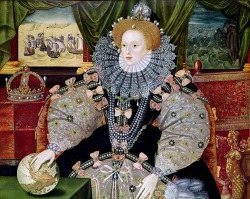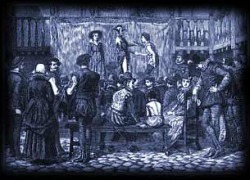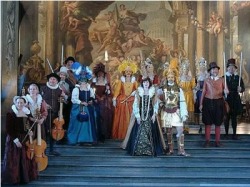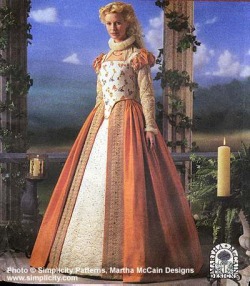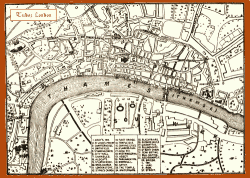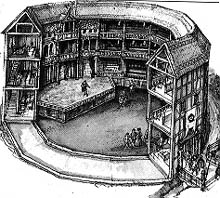Elizabethan Theater
Google Images
Costumes
By Maura Howard
A Lot has changed from the past to the present in many ways such the way people dress and theater arts. The costumes used in Elizabethan theater are very different form the costumes used today. Back then every person dressed very formal no matter what class. If you where rich or poor they all dressed formal and classy. There are laws pertaining to the way people can dress. These laws followed over to theater arts. The way the actors and actresses dressed was very classy. The people playing the ladies of the play would wear a dress called an Elizabethan Dress. The Elizabethan Dress was extremely complicated. With the dress, they wore hip pads, hip roles or a farthingale these items give the hip a flare and are adjustable. The hip pad was a padded bump worn on the hips and gives the dress a little hump in the hips. The hip role is a padded waist belt that goes all the way around and ties at the front. The farthingale is a wired skirt that gives the dress a flare and is worn underneath the dress. The men on the other hand wore tighter pants and always had to be stretched. To make the pants stretched out someone either had to wear them before or they were placed on a dress stand to stretch out. Other than the pants they either wore leotards or tights. You can see that from today and the Elizabethan era costumes has changed a lot and so did other things.
Google Images
This picture shows a performance at an Inn Yard with people all around to watch.
This picture shows a performance at an Inn Yard with people all around to watch.
Sites of London
By Carlee Wickstrom
London was unquestionably a city of wealth and spectacle, but it was also a dirty and disease-ridden. London at that time of Shakespeare had more than 200,000 residents. The Thames, a river in Cotswold Hills in England’s western Midlands snaked it’s way more than 200 miles southeastward to London and the sea. The river was a pathway in the city’s life, carrying rowboats, barges, and sailing ships. The river divided Greater London into northern and southern sections. The London Bridge, constructed between 1176 and 1209, was the only walkway connecting the northern and southern sections. On the south sections of the bridge Shakespeare staged plays at the Globe Theatre, built in 1599 west of London Bridge in an area known as Bankside. The south section was the wild side haven for drunks, prostitutes, con men, gamblers, and thieves. The Middle Temple another site to see is one of the oldest inns of the Court was design to both dine and entertain. There are numerous sites to see in London and these are just a few of them.
Google Images
The characters above were part of a masque with some people still in their unique masks.
The characters above were part of a masque with some people still in their unique masks.
Elizabethan Theaters
By Maggie O'Hare
Elizabethan Theaters all started out with a man named James Burbage. James came up with the idea to make a building where you could just watch the plays instead of the plays traveling from inn yard to inn yard. After he made the first theater called “The Theater”, other people started creating amphitheaters, which are theaters typically without a roof and rounded with a stage in the middle. Around 1593, theaters started closing due to an outbreak of the Bubonic Plague. Once they got some running again, another outbreak occurred in 1603, causing them all to close down again. The theaters were said to be a health hazard with the amounts of people. You needed leases to open theaters and have permission to have plays in them. Theaters were a huge part of the Elizabethan Era and where Shakespeare became famous.
You can try checking out these sites!
http://www.folger.edu/template.cfm?cid=1062weeblylink_new_window
http://www.elizabethan-era.org.uk/elizabethan-clothing.htmweeblylink_new_window
http://www.folger.edu/template.cfm?cid=1062weeblylink_new_window
http://www.elizabethan-era.org.uk/elizabethan-clothing.htmweeblylink_new_window
Google Images
This is a what the women in the Elizabethan Era would wear.
This is a what the women in the Elizabethan Era would wear.
Inn Yards
By Maura Howard
We all know that when you go somewhere you usually stop at a hotel, motel or inn. Back in the Elizabethan Era Theater performers would put on shows in the inn yards. The performers would travel and find an inn that they would constantly perform at. They would travel all around to find an inn and have to get the owners to let them perform. They would usually have to negotiate with the inn owners. When they would do this more customers would come so both the performers and the inn would benefit. Soon enough this idea became popular. So in the inn yards the performers would put on a show and make money off of it. The Inns were built around a yard so you could watch from your rooms. The higher class could pay for a balcony and watch and others watched from the floor. The inns always prepared themselves in many ways. The inns counted on these performances to get a profit. Some of these inns names are The Bull Inn, The Bell Savage Inn and The George Inn. Instead of going to see a show at a theater today back in the Elizabethan Era they performed shows at inn yards.
Google Images
The map above shows you an old London, Elizabethan Era, map with the Thames River running through this location.
The map above shows you an old London, Elizabethan Era, map with the Thames River running through this location.
Masques
By Maggie O'Hare
Elizabethan Masques were a form of entertainment that one might say was a short play that always included masks. These masques were preformed on events such as Christmas or weddings. They were a most enjoyable form of entertainment in the Elizabethan Era. The sets would be very critical to how the masques were. They sets were be painted beautifully and the furniture would be very expensive. Masques were usually played for honorable people such as the Queen Elizabeth. One amazing thing also was that women were allowed to be actresses in these masques. They were not allowed to be on the Elizabethan Stage, but many women participated in the masques, even Queen Elizabeth’s mother, was in quite a few. This was probably due to the face that they were wearing masks, so sometimes one would not even know it was a woman. Masques back then, were such a great entertainment in the arts world of the Elizabethan Era.
Google Images
This is a typical type of theater in the Elizabethan Era.
Works Cited
Alchin, Linda. Elizabethan Masques. Elizabethan Era. May 16, 2005. Web. 21 February 2010. <http://www.elizabethan-era.org.uk >
Best, Michael. Shakespeare's Life and Times. Internet Shakespeare Editions, 2001- 2005. Web. 21 February 2010. <http://ise.uvic.ca/Library/SLT/intro/introcite.html>.
Brown, Ivor. Shakespeare and His World. New York: Henry Z Walck,, 1964. Print.
Wilson, Ian. Shakespeare the Evidence. New York: St. Martin's, 1993. Print.
Adam, Woog. A History of Elizabethan Theater. San Diego: Lucent, 2003. Print.
Alchin, Linda. “Elizabethan Costumes.” Elizabethan Era. Linda Alchin, 1 Feb. 2007. Web. 1 Feb. 2010. <http:/.elizabethan-era.org>.
Jackson, Sheila. Simple Stage Costumes and How to Make Them. London: Studio Vista, 1968. Print.
Best, Michael. Shakespeare's Life and Times. Internet Shakespeare Editions, 2001- 2005. Web. 21 February 2010. <http://ise.uvic.ca/Library/SLT/intro/introcite.html>.
Brown, Ivor. Shakespeare and His World. New York: Henry Z Walck,, 1964. Print.
Wilson, Ian. Shakespeare the Evidence. New York: St. Martin's, 1993. Print.
Adam, Woog. A History of Elizabethan Theater. San Diego: Lucent, 2003. Print.
Alchin, Linda. “Elizabethan Costumes.” Elizabethan Era. Linda Alchin, 1 Feb. 2007. Web. 1 Feb. 2010. <http:/.elizabethan-era.org>.
Jackson, Sheila. Simple Stage Costumes and How to Make Them. London: Studio Vista, 1968. Print.
